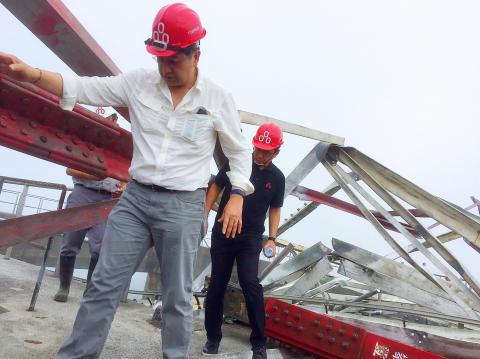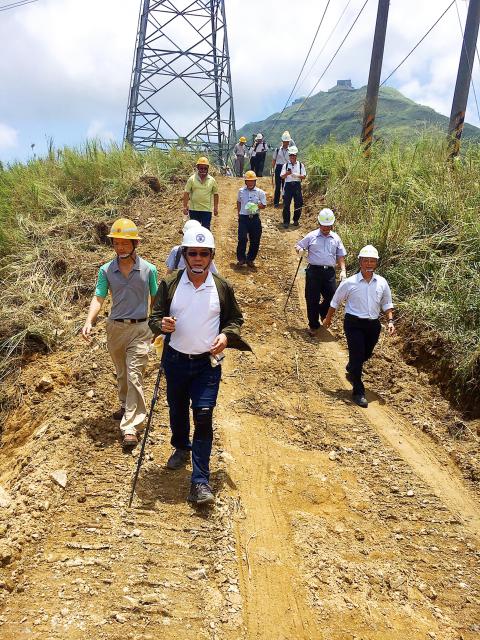State-run Taiwan Power Co (Taipower, 台電) is to increase the number of electrical circuits on transmission towers to improve the durability of the nation’s power grid, Minister of Economic Affairs Lee Chih-kung (李世光) said yesterday.
The improvement is part of a slew of measures being taken to protect the nation’s power facilities from natural disasters, he said.
“The power grid’s exposure risk is greater than that of power plants during natural disasters... We have asked Taipower to propose improvement plans,” Lee told reporters before the Ministry of Economic Affair’s weekly meeting.

Photo courtesy of Taiwan Cement Corp
The majority of the power supply warnings issued by Taipower since the 921 Earthquake in 1999 were caused by disruptions to the power grid rather than problems with power generaton, Lee said.
Almost all of the transmission towers in the nation are equipped with one electrical circuit each, which makes the power grid vulnerable to external forces, Taipower said.
The company has yet to decide whether to add electrical circuits to all towers or select a few areas to improve the power grid, as the plan involves a large investment, Lee said.

Photo courtesy of the Ministry of Economic Affairs
Adding new circuits to high-voltage towers might require personnel to work in the mountains and traverse national parks, which adds to operational difficulties, he added.
Increasing the electricity contribution from renewable sources is one of several measures to spread risk, as “green” energy facilities supply power to a smaller number of users in a designated area, which makes the power grid more resilient as transmission lines are shorter, Lee said.
The ministry’s priority is to restore the power supply from the privately-run Ho-Ping Power Co (和平電力), after a transmission tower in Yilan County collapsed on Saturday due to severe weather brought by Typhoon Nesat, Lee said.
The ministry aims to enhance the power transmission infrastructure there, he said.
Taipower finished building temporary power lines yesterday and sent equipment to the Dongao (東澳) area to repair the tower, Lee said, adding that the company would build a double-circuit temporary transmission tower instead of a single-circuit tower.
Ho-Ping Power is inspecting the condition of the power generators at the plant, as they might have been damaged when power transmission was abruptly cut while they were working at full capacity, Vice Minister of Economic Affairs Yang Wei-fu (楊偉甫) said.
The ministry estimates that Ho-Ping Power will resume electricity generation on Sunday next week at the earliest, Yang said.
The power plant generates 1.3 million kilowatts, or about 4 percent of the nation’s operating reserve margin. It mainly supplies power to northern Taiwan.
The nation’s operating reserve margin is estimated to drop to 4.43 percent today, which means power supply remains tight, Taipower data showed.
The margin is expected to fall to 2.41 percent on Wednesday and Thursday, meaning it will be lower than 900,000 kilowatts, Taipower said.

SELL-OFF: Investors expect tariff-driven volatility as the local boarse reopens today, while analysts say government support and solid fundamentals would steady sentiment Local investors are bracing for a sharp market downturn today as the nation’s financial markets resume trading following a two-day closure for national holidays before the weekend, with sentiment rattled by US President Donald Trump’s sweeping tariff announcement. Trump’s unveiling of new “reciprocal tariffs” on Wednesday triggered a sell-off in global markets, with the FTSE Taiwan Index Futures — a benchmark for Taiwanese equities traded in Singapore — tumbling 9.2 percent over the past two sessions. Meanwhile, the American depositary receipts (ADRs) of Taiwan Semiconductor Manufacturing Co (TSMC, 台積電), the most heavily weighted stock on the TAIEX, plunged 13.8 percent in

A wave of stop-loss selling and panic selling hit Taiwan's stock market at its opening today, with the weighted index plunging 2,086 points — a drop of more than 9.7 percent — marking the largest intraday point and percentage loss on record. The index bottomed out at 19,212.02, while futures were locked limit-down, with more than 1,000 stocks hitting their daily drop limit. Three heavyweight stocks — Taiwan Semiconductor Manufacturing Co (TSMC, 台積電), Hon Hai Precision Industry Co (Foxconn, 鴻海精密) and MediaTek (聯發科) — hit their limit-down prices as soon as the market opened, falling to NT$848 (US$25.54), NT$138.5 and NT$1,295 respectively. TSMC's

ASML Holding NV, the sole producer of the most advanced machines used in semiconductor manufacturing, said geopolitical tensions are harming innovation a day after US President Donald Trump levied massive tariffs that promise to disrupt trade flows across the entire world. “Our industry has been built basically on the ability of people to work together, to innovate together,” ASML chief executive officer Christophe Fouquet said in a recorded message at a Thursday industry event in the Netherlands. Export controls and increasing geopolitical tensions challenge that collaboration, he said, without specifically addressing the new US tariffs. Tech executives in the EU, which is

In a small town in Paraguay, a showdown is brewing between traditional producers of yerba mate, a bitter herbal tea popular across South America, and miners of a shinier treasure: gold. A rush for the precious metal is pitting mate growers and indigenous groups against the expanding operations of small-scale miners who, until recently, were their neighbors, not nemeses. “They [the miners] have destroyed everything... The canals, springs, swamps,” said Vidal Britez, president of the Yerba Mate Producers’ Association of the town of Paso Yobai, about 210km east of capital Asuncion. “You can see the pollution from the dead fish.